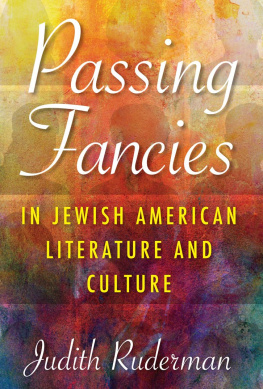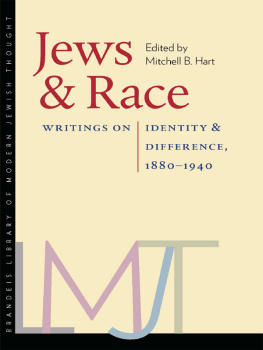First published 2012 by Paradigm Publishers
Published 2016 by Routledge
2 Park Square, Milton Park, Abingdon, Oxon OX14 4RN
711 Third Avenue, New York, NY 10017, USA
Routledge is an imprint of the Taylor & Francis Group, an informa business
Copyright 2012, Taylor & Francis.
All rights reserved. No part of this book may be reprinted or reproduced or utilised in any form or by any electronic, mechanical, or other means, now known or hereafter invented, including photocopying and recording, or in any information storage or retrieval system, without permission in writing from the publishers.
Notice:
Product or corporate names may be trademarks or registered trademarks, and are used only for identification and explanation without intent to infringe.
Library of Congress Cataloging-in-Publication Data
Reznik, David L.
New Jews? : race and American Jewish identity in 21st-century film / David L. Reznik.
p. cm.
Includes bibliographical references and index.
ISBN 978-1-61205-071-3 (hardcover : alk. paper)
1. Jews in motion pictures. 2. Race in motion pictures. 3. Stereotypes (Social psychology) in motion pictures. 4. Motion picturesUnited StatesHistory21st century. I. Title.
PN1995.9.J46R49 2012
791.436552dc23
2011050898
Designed and Typeset by Straight Creek Bookmakers.
ISBN13: 978-1-61205-071-3 (hbk)
ISBN13: 978-1-61205-072-0 (pbk)
This book is the first comprehensive study of American Jewish identity in Hollywood movies of the new millennium. Surveying more than fifty films of the past decade, it details the ways that four of the most prominent stereotypes of American Jews in 20th-century film persist in todays cinema. Whether Hollywood blockbusters like Meet the Fockers and Sex and the City or indie favorites like Garden State and Kissing Jessica Stein, 21st-century film continues to feature dozens of American Jewish meddling matriarchs, neurotic nebbishes, pampered princesses, and scheming scumbags, and in this book you will find discussion of characters embodying these stereotypes played by the likes of Jim Carrey, Tom Cruise, Anne Hathaway, Kate Hudson, Scarlett Johansson, Sarah Jessica Parker, Adam Sandler, and Ben Stiller.
At the same time, this book also illuminates how American Jewish identity has changed on the big screen in recent years. The traditional American Jewish stereotypes of family dysfunction, emasculated insecurity, feminine hyper-materialism, and conniving deceit have taken on new forms in contemporary film, and these changes are documented and explained throughout the text. Most notably, these stereotypes have expanded across age, gender, and sexuality lines to include a wider umbrella of American Jewish characters, shifts that are linked to larger 21st-century trends in family life and identity politics across U.S. society.
Here you will also find an important discussion of the disproportionate role American Jewish creative teams (i.e., directors/writers) play in the production of these stereotypes, a phenomenon that is linked not only to the issue of contemporary racial identity politics but also to the larger political economy of globalization and neoliberalism as well. Significant differences in the portrayal of American Jewish characters between bigbudget film and independent cinema are also addressed, particularly the fact that the latter tends to explore more explicit and assertive forms of American Jewish identity given the relatively lesser degree of profitability pressure felt in that arena of filmmaking.
Regarding the origins of this project, it is important to note that while the subject of racial stereotypes in film was well researched in the latter half of the 20th century, the increasingly popular idea that America is becoming a postracial society has created a social climate that discourages such study today. This broader issue is magnified when dealing with a group like American Jews, whose successful assimilation in U.S. society has led to the popular notion that they are just another bunch of white folks. Within such a context, it may seem irrelevant to reexamine the stereotyping of American Jews in contemporary film.
However, it is the fundamental premise of this book that American Jews are indeed a racial minority in U.S. society, even if they represent the quintessential model minority. After all, American Jews are a racial group that is protected by anti-discrimination laws thanks to a 1987 Supreme Court ruling (Gibel Azoulay 93), and it would be somewhat nave to believe that there would be no lingering effects from the centuries-old, European-imported racialization of American Jewish identity in U.S. society. Moreover, film-studies circles have been abuzz with the idea that a new Jew is emerging onscreen, one who supposedly subverts, transcends, and/or redefines traditional American Jewish stereotypes. Therefore, it is quite prudent and timely to explore the portrayals of American Jews in todays cinema, not only to assess the present state of racial stereotypes about American Jewish identity but also to test these claims about the emergence of a new Jew in Hollywood film.
A more personal impetus for this book comes out of ambivalence about my own racial identity as an American Jew. The son of Jewish immigrants from the former Soviet Union, I was raised in predominantly white Anglo-Saxon Protestant (W.A.S.P.) surroundings and have spent many years reflecting upon two contradictory forces that shaped my sense of self: the often quite overt antisemitism I experienced growing up as well as the honorary white privilege from which I have benefitted. Along the way, I have come to realize how immense an impact mass media, particularly film, has had on my racial identity. Famous American Jewish characters played by Woody Allen, Robin Williams, Barbra Streisand, and Jennifer Grey deeply informed my understanding of how a Jew in American society behaves, looks, and thinks, and it is only after studying the evolution of the American Jewish cinematic stereotype that I have come to realize both the pervasiveness of these images and the depth of their influence on the identity of millions of Jews in the United States.
Current, topical, and written in clear and readable prose, this book should appeal not only to students and scholars of sociology, film, and Jewish studies but also to those who have a more general interest in Hollywood movies, racial stereotypes in the mass media, and American popular culture. For those who do wish to delve into the more formal academic elements of the text, I have included an appendix that presents detailed discussions about the theoretical frameworks and research methodology for the book. And for those who have been assigned this text in one of your courses, there are discussion questions and additional readings listed at the end of each chapter to help facilitate the learning process. Regardless of your specific interest in the book, I hope that you will find my analysis of American Jewish racial identity in 21st-century film both enlightening and provocative, as I believe it is crucial that we as a society begin to reengage in public debate on larger questions of U.S. race relations despite the postracial rhetoric with which we seem to be inundated on a daily basis.












